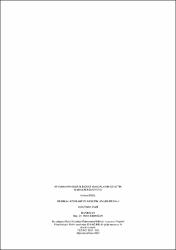Afyonkarahisar ilindeki mandaların genetik karakterizasyonu
Abstract
Bu proje, Afyonkarahisar ili manda popülasyonunun heterozigotluk / homozigotluk düzeyini belirlemek, Türkiye’deki manda popülasyonları arasındaki ilişkileri açıklamaya yönelik çalışmalara zemin oluşturmak, Manda ebeveyn tayini için kullanılabilecek test paneli geliştirmek, incelenen lokuslar yardımıyla ebeveyn kontrolü de yaparak Afyonkarahisar ilinde T.C. Gıda, Tarım ve Hayvancılık Bakanlığı TAGEM tarafından yürütülen “Mandaların Halk Elinde Islahı Projesine” genetik analizlerle destek olarak seleksiyon hızını artırmak amacıyla yapılmıştır.
Bu çalışmada 21 mikrosatellit lokus kullanılmıştır ve bu mikrosatellit lokuslardan 2 (AME ve CCMB154) lokus dışında 19 (BMS922, CCMB005, CCMB113, CCMB116, CCMB117, CCMB125, CCMB126, CCMB159, CCMB164, CCMB168, DIK1129, DIK1182, DIK1192, DIK2204, DIK2700, DIK3023, DIK3028, IOBT34 ve TGLA23) lokus da Anadolu mandalarında polimorfizm belirlenmiştir. İncelenen 19 mikrosatellite lokusunda toplam 155 farklı allel belirlenmiştir. Allel sayısı CCMB113 ve TGLA23 lokusunda en yüksek (13 allel), DIK3028 lokusunda ise en düşük (4 allel) bulunmuştur. Lokus başına düşen ortalama allel sayısı 8,158 olarak hesaplanmıştır.
Ortalama Heterozigotluk değerleri; CCMB113 lokusunda en yüksek (0,839), DIK3023 lokusunda ise en düşük (0,143) tespit edilmiştir. Çalışılan 19 mikrosatellit lokusları birlikte değerlendirildiğinde ortalama heterozigotluk değeri; 0,651 olarak hesaplanmış ve bu değerin oldukça yüksek olduğu belirlenmiştir. Bunun nedeni incelenen lokusların heterozigotluk değerleri Anadolu mandalarında genetik varyasyonun yüksek olduğu kanısına varılmıştır. Her bir lokus bakımından exact test sonucu beklenen ve gözlenen değerler arasındaki farklar 14 mikrosatellit lokusta (P<0,001, P<0,01 ve P<0,05) önemli ilişki bulunurken; 5 mikrosatellit lokusta (CCMB126, DIK2204, DIK2700, DIK3023 ve DIK3028) önemsiz bulunmuştur.
Bu çalışmada kullanılan mikrosatellit markerların polimorfizm bilgi içerikleri (PIC) genel anlamda yüksek bulunmuştur. Polimorfizm bilgi içeriği (PIC) değeri en yüksek CCMB113 lokusunda (0,817), DIK3023 lokusunda ise en düşük (0,139) olarak tespit edilmiştir. DIK3023 lokusunun PIC değeri düşük olduğu için Anadolu mandalarında yapılacak genetik çalışmalarında kullanılmasının çok faydalı olmayacağı söylenebilir. İncelenen tüm malakların ortalama PIC değeri 0,607 olarak bulunmuştur ve kullanılan lokusların polimorfizm belirlenmesinde yüksek oranda bilgi verici olduğu ve bu lokusların mandalarda genetik karakterizasyon çalışmalarında kullanılabileceği sonucuna varılmıştır.
Dışlama gücü (DG-1 ve DG-2) değerleri sırasıyla; en yüksek ise; CCMB113 ve TGLA23 lokuslarında (0,726 ve 0,842), en düşük DIK3028 lokusunda (0,328 ve 0,504) olduğu tespit edilmiştir. Bu çalışmada kullanılan mikrosatellit lokusların toplam DG-1 ve DG-2 değerleri 0,999 ve 1,000 olarak hesaplanmıştır.
Sonuç olarak, mandaların genetik yapılarını belirlemede, koruma/ıslah programlarında sürüdeki mandaların genetik olarak incelemesinde polimorfik mikrosatellit lokuslarının kullanılabileceği; manda popülasyonlarını karşılaştırmada ortalama heterozigotluk değerlerinden, exact test olasılıklarından ve PIC değerinin kullanılabileceği kanısına varılmıştır. PIC değerinin yüksek çıkması ve kullanılan mikrosatellite lokusların bir veya iki multipleks PCR ile çoğaltılabilmesi bu lokusların mandalarda pedigri analizlerinde kullanılabileceğini göstermektedir. This project aims to determine the heterozygosity / homozygosity level of the Afyonkarahisar city buffalo population, to establish a groundwork for explaining the relations between the buffalo populations in Turkey, to develop a test panel that can be used for parental identification in buffalo and to conduct parental control with the help of investigated loci. The Ministry of Food, Agriculture and Livestock carried out by the TAGEM to support the "Buffalo People's Reclamation Project" with genetic analysis and to increase the speed of selection.
In this study, 21 microsatellite loci were used to determine the genetic structures of the Anatolian buffalos and polymorphsim was determined at 19 (BMS922, CCMB005, CCMB113, CCMB116, CCMB117, CCMB125, CCMB126, CCMB159, CCMB164, CCMB168, DIK1129, DIK1182 , DIK1192, DIK2204, DIK2700, DIK3023, DIK3028, IOBT34 and TGLA23) locus except 2 (AME and CCMB154) locus from these microsatellite locus. A total of 155 different alleles were found in the 19 microsatellite loci examined. Allel number was found highest in CCMB113 and TGLA23 (13 alleles) and lowest in DIK3028 (4 alleles). The average number of alleles per locus was calculated as 8,158. Mean Heterozygosity values; The highest in CCMB113 (0.839) and the lowest in DIK3023 (0.143) were found. When the 19 microsatellite loci studied were evaluated together, the mean heterozygosity value was calculated as 0.651 and this value was observed to be quite high. The reason for this is that the genetic variation in Anatolian buffalos is high in terms of the loci examined. For each locus, the difference between the observed and expected values of the Chi-square and Exact test results was found to be significant in the 14 microsatellites (P<0,001, P<0,01 ve P<0,05), whereas it was not significant in the 5 microsatellites (CCMB126, DIK2204, DIK2700, DIK3023 ve DIK3028).
The polymorphism information content (PIC) of the microsatellite markers used in this study is generally high. The polymorphism information content (PIC) value was found to be highest in CCMB113 (0.817) and lowest in DIK3023 (0.139). Since the DIK3023 loci has a low PIC value, it can be said that it would not be very useful to use it in genetic studies to be performed in Anatolian buffalo. The mean PIC value of all studied buffalo was found to be 0.607. The polymorphism of the loci used is highly informative and the locus can be used for genetic characterization studies.
Probability of Exclusion (DG-1 and DG-2) values were found; the highest at CCMB113 and TGLA23 locuses (0,726 and 0,842), the lowest at DIK3028 locus (0,328 and 0,504), respectively. The total DG-1 and DG-2 values of the microsatellite loci used in this study were calculated as 0,999 and 1,000.
As a result, in determining the genetic structure of buffalos, it has been concluded that polymorphic microsatellite loci can be used in the genetic review of the herd of buffalos in conservation / breeding programs, the average heterozygosity values in comparing buffalo populations, exact test probabilities and PIC value can be used. The fact that the PIC value is high and that the microsatellite loci used can be amplified by one or two multiplex PCR can demonstrate that these loci can be used for pedigree analyzes in buffalo.
Collections
- Doktora Tezleri [154]



















